
RCAF 426 Transport Squadron Logo
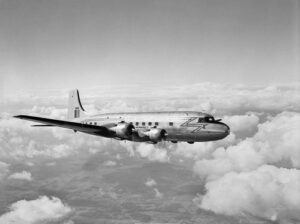
RCAF Canadair North Star
“Operation Hawk”, (July 25 1950 to May 25 1954) to the Canadian military
portion of the Korean War airlift.
The 426 Transport Squadron flew 12 Canadair C-54GM North Stars on 599
round trips (34,000 Flight hours) over the north Pacific, transporting 13,000 personnel and three million kilograms of freight and mail to Japan. There, cargo was offloaded for onward transit to Korea.
RCAF Squadron Leader Andy MacKenzie was the only Canadian airman who became a Prisoner of War (POW) during the Korean War.
The last official Canadian casualty of the Korean War, Major Edward Gower, was on his return flight from Korea to Calgary in December 1956 when his TCA North Star hit Mount Slesse (near Hope, British Columbia). The wreckage was found in May 1957 and the remains of all 62 crew and passengers rest on the mountain to this day.
Canadians received 57 Commonwealth and US awards, medals, and commendations.
RCAF pilots received eight U.S. Distinguished Flying Crosses and 10 U.S. Air Medals. Flight Lieutenant Ernest Glover was the last and only RCAF pilot to be awarded the Commonwealth Distinguished Service Cross since the Second World War.

North Star

North Star
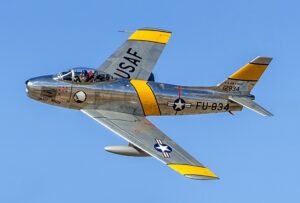
F-86 Sabre
Flight Lieutenant Omer Lévesque, (who was already serving on exchange
with the Americans when the war broke out) volunteered to fly F-86 Sabres with the United States Air Force.
On December 17, Flight Lieutenant Lévesque took flight with the squadron’s first operational sortie, taking on Soviet MiG-15s.
He thus became the first Canadian and the first Commonwealth pilot to engage in jet-to-jet combat. He was also the first RCAF member to score a victory during the Korean War.
Lévesque earned the U.S. Air Medal by flying 20 missions from December 17 to 20. On March 30, 1951, while flying as part of an escort of B-29 bombers, he earned the American Distinguished Flying Cross for his dogfight with several MiGs. The aircraft he shot down during that fight earned him the title “ace”.
Captain Patrick (served during WWII and Communication Expert) flew on
six B-29 bombing missions and acted as the radar officer to analyze enemy radar and the available counter-measures equipment.
High scoring pilots included Flight Lieutenant (F/L) Ernie Glover with three
kills and three damaged, and Squadron Leader (S/L) Doug Lindsay with two kills and three damaged.
RCAF flight nurses were trained at Gunter Air Force Base in Alabama and
then participated in three month tours of duty carrying out medical
evacuations (medevacs) from the South Pacific. 40 Canadian flight nurses
were involved in nearly 250 medical evacuation flights from 1950 to 1955,
bringing the wounded and injured from Tokyo through Honolulu and back
to North America.

RCAF Air Crew

Flight Lieutenant Ernie Glover
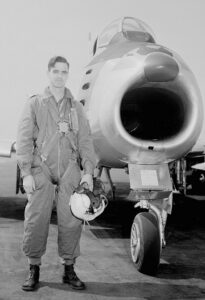
Flight Lieutenant Ernie Glover
Please click the link below to read the Article ![]()
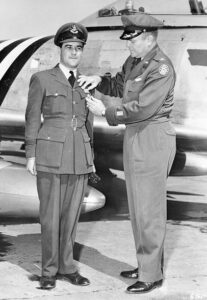
Flight Lieutenant Omer Lévesque

Flight Lieutenant Omer Lévesque
https://beechwoodottawa.ca/en/blog/ace-fighter-pilot-flight-sergeant-joseph-auguste-omer-levesque

Andy Mckenzie, POW
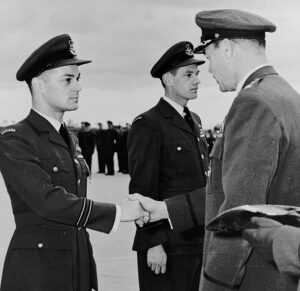
Claude LaFrance

Claude LaFrance enrolled in the Royal Canadian Air Force (RCAF) in 1947
and, after receiving his wings in 1948 at Centralia, Ontario, flew the
DH-100 Vampire – Canada’s first jet fighter. When the Korean War broke
out, he was instructing on that aircraft at the fighter school in Chatham,
New Brunswick.
The Americans were flying F-86 Sabres in Korea and the school switched
to the Sabre in early 1952. So the young instructor was seconded to
the U.S. Air Force to gain combat experience.
“At that time, the Sabre was the only aircraft that had a chance against the Russian MiGs,” LaFrance said.
May 1952, F/L Claude LaFrance was in Korea, flying as a wingman with
39 Fighter Interceptor Squadron in a Canadian-built Sabre. By the time
he returned to Canada in October 1952, he had flown 50 missions, been
promoted from flying officer to flight lieutenant, commanded a patrol
of four aircraft and later a flight of 16 aircraft, and had shot down a
MiG-15 (the pilot bailed out).
The Americans awarded him the Distinguished Flying Cross and the Air
Medal for that success and for his leadership during his tour.
He served for 34 years with RCAF and retried as a Major-General.
Sources and photos credited to: RCAF and Veterans Affairs Canada
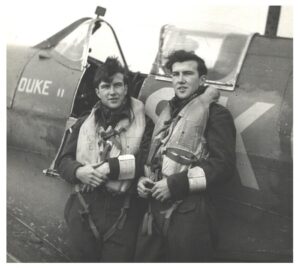
Lt. Col. Douglas Warren(Right) with his twin brother Bruce
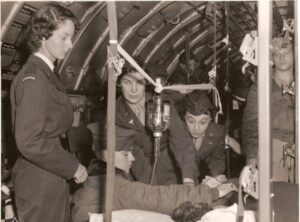
RCAF Air Nurses
“Operation Hawk”
To fly high and far over the land
that they’ve never been to
To fight fiercely and win for the people
who they’ve never known
426 Squadron transported troops and cargo
with RCAF North Star planes
The brave 22 RCAF Airmen who fought beside the USAF
with F-86 Sabre Fighter jets
40 RCAF Air nurses cared for the many wounded
by their side as they returned home
“Operation Hawk” was the code name
of the Korean War Airlift.
Raising from the ashes and ruins of War
a free Korea is reaching for the stars
Saluting unsung heroes who came
from thousands of miles away.
~ By HooJung Jones Kennedy ~
Member of RCAF 447 Wing

© Korean War Veterans Advocates of Canada